
Thrace
The region of Thrace spans the modern countries of Bulgaria, Greece, and Turkey. The portion of Thrace that is located in Greece is referred to as West Thrace. Its capital is Komotini and its largest city is Alexandroupoli. Other well known cities are Didymoteicho, Orestiada, and Xanthi.
Popular dances from Thrace
Antikristos, Baindouska (Kavakli), Isia Apan Kalinitikos, Koulouriastos (Evros), Mantilatos, Podaraki (Refugees of Eastern Rumelia), Sfarlis (Bana), Stis Treis (Refugees of Kavakli), Syrtos, Tapeinos, Trapanistos (Kitros), Troiro (Kavakli), Tsestos (Refugees of Kavakli), Yariska (Aimonas), and Zonaradikos
Costumes from Thrace
| This costume is from the village of Metaxades in Western Thrace. The first piece of this costume is a shirt that is decorated with embroidery and lace (called “kinades”). The regional Thracian “tsouka” is worn over the shirt. The “tsoukna” is a sleeveless jumper made in various colors. The opening of the “tsoukna” (the “laimaria”) is embroidered with colored sequins, threads, and ribbons. The costume also features holes through which women breast-fed their infants. The apron is decorated with embroidery and ribbons. Extra hair is added to the woman’s hair in order to make a long braid. The hair is then secured by the headdress (the “barboula”). The “barboula” is composed of a monochrome scarf, which is covered by a printed scarf seen in various colors. The stockings are made from wool and feature a pattern. Slippers (called “terlikia”) made of cloth are also worn. | 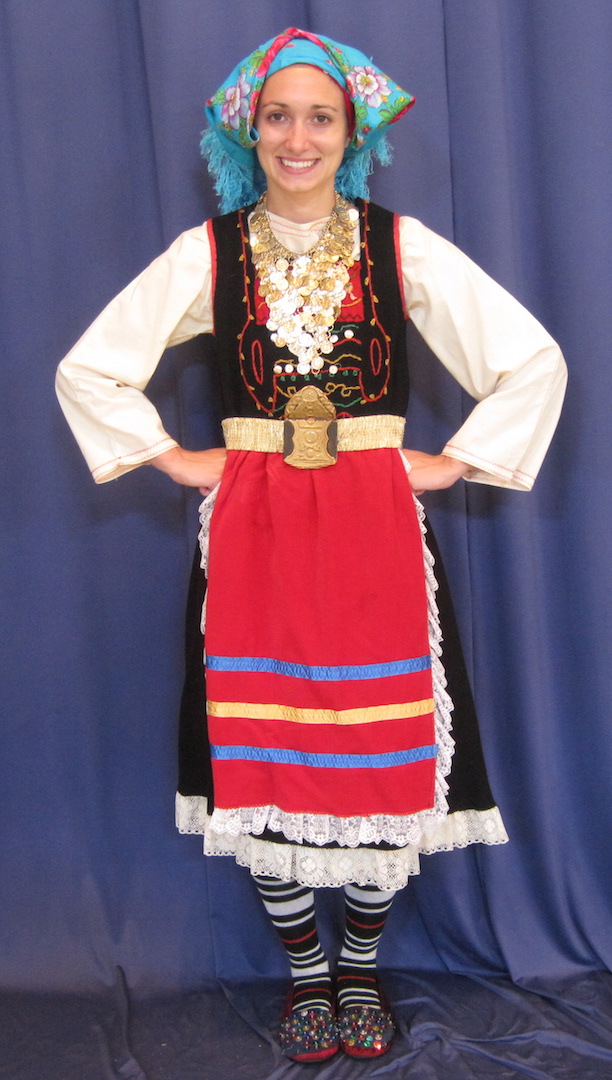 |
 |
||
| This is the costume of the “Marides”, which were inhabitants of the 13 villages in between Didymoteicho and Orestiada, Thrace. Some of these villages are Karoti, Hioades, and Poimeniko. This costume is composed of the cotton shirt, the black sleeveless coat (the “tsoukna”), the sleeveless dress, the woolen apron (the “misalouda”) decorated with lace, sequins, ribbons, and vivid colors, and the headscarf. During special events, closed slippers (“gemenia”) or heeled shoes (“kontouria”) were worn with white or black monochrome socks. They also traditionally made cloth shoes with embroidered multicolored threads and sequins, called “mestia.” Younger women wore a yellow scarf with flowers, called the “barboula.” Over the yellow scarf, a white woven scarf was added. | 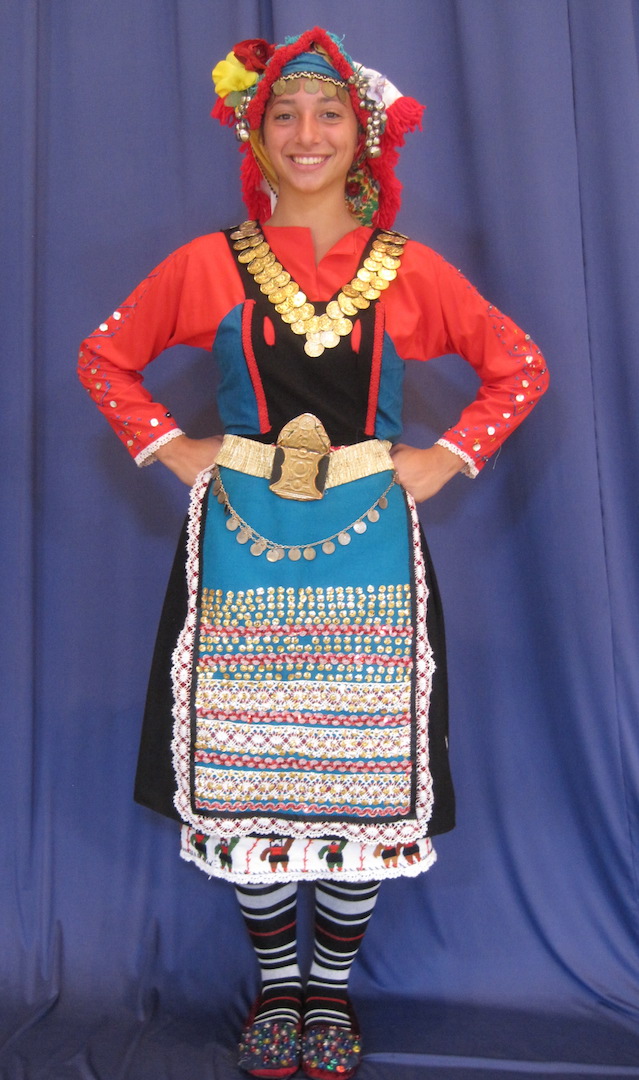 |
 |
||
| This is a bridal and festival costume from Makra Gefyra, a region that is now part of Turkey. After the population exchange of 1922-23, its inhabitants scattered throughout Western Macedonia and Thrace. The costume consists of a cotton chemise and sleeveless one-piece dress embroidered with special motifs. Both the long-sleeved overcoat and the apron have all-over embroidery. The waist is belted with a red sash, a common color in the attire of Makra Gefyra. On the feet are white boots and on the head is a cap that fastens under the chin and is covered entirely by a kerchief. |  |
|||
| The people of Kavakli arrived as refugees to Thrace, a northern province of Greece. The women wove and embroidered all their own clothes. On the Kavakli costume, the undermost piece is a dress with the top part in blue and the bottom skirt portion in white. The neck, cuffs, and hem were richly embroidered. A dark, pleated sleeveless tunic (the “tsounka”) is worn over the undershirt. The tunic was kept shorter than the shirt underneath so as not to obstruct the intricate embroidery. A 4-meter-long woolen sash, usually red with multicolored strips, is wrapped around the waist. Over this is tied a multicolored and embroidered woolen apron. The headpiece consists of a large woolen scarf, usually in a floral pattern. The ends hang down loose over the shoulders. A decoration consisting of coins arranged in the shape of a cross hangs down over the forehead to showcase the refugees’ steadfast belief in their religion. | 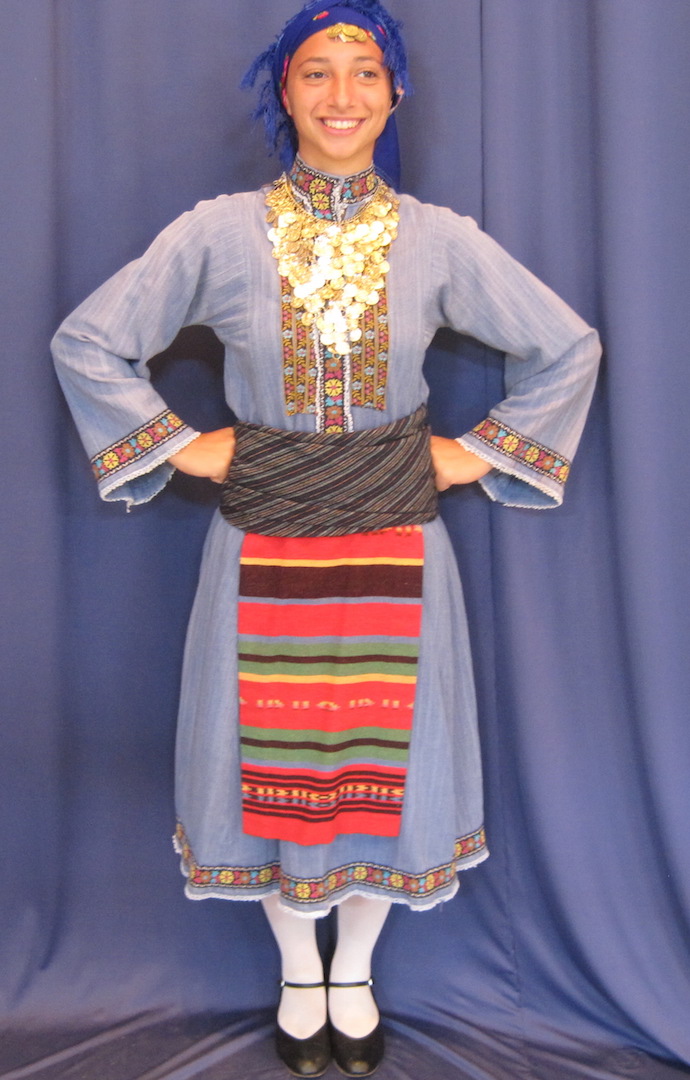 |
 |
||
| This costume is from Anatolian Romylia, Thrace, specifically the region of Kavakli. This brown costume, called the “bozaviarikia”, was part of the daily attire of the refugees from this area. The pants of this costume are called “poutouria” and are typical of many of the Thracian costumes. |  |
 |
||
| This is the male costume from the region of Evros, Thrace with variations seen throughout all of Thrace. The costume is composed of a woolen sash, which is typically red, burgundy, black, or blue depending on the region. The men also wore a woolen hat that was adorned with a silver pendant. | 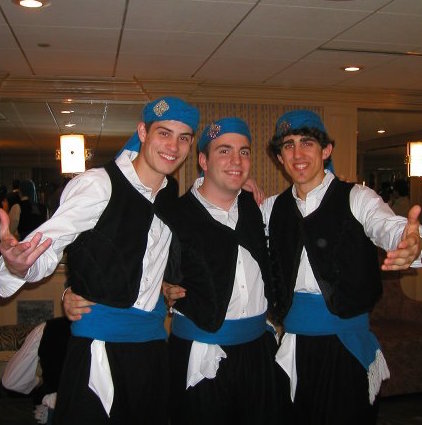 |
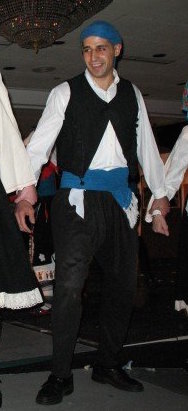 |
||
| This is the bridal costume worn by the Sarakatsani people of Thrace. The main pieces of the costumes are the knitted wool leggings (the “tsourapia”), the shoes with pompoms ( the “tsarouhia”) that the brother-in-law put on the bride’s feet when she was given to the bridegroom in the wedding procession, the pleated skirt (the “fousta”) that fastens to the sleeveless buttoned waistcoat (the “panaoula”), the apron whose decoration was associated fertility, and the belt (the “foki”), which was believed to guarantee strength and health. The handmade headscarf (the “boho”) was worn on the head. | 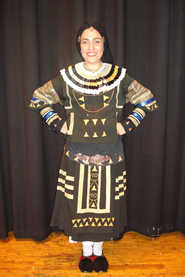 |
 |
||
